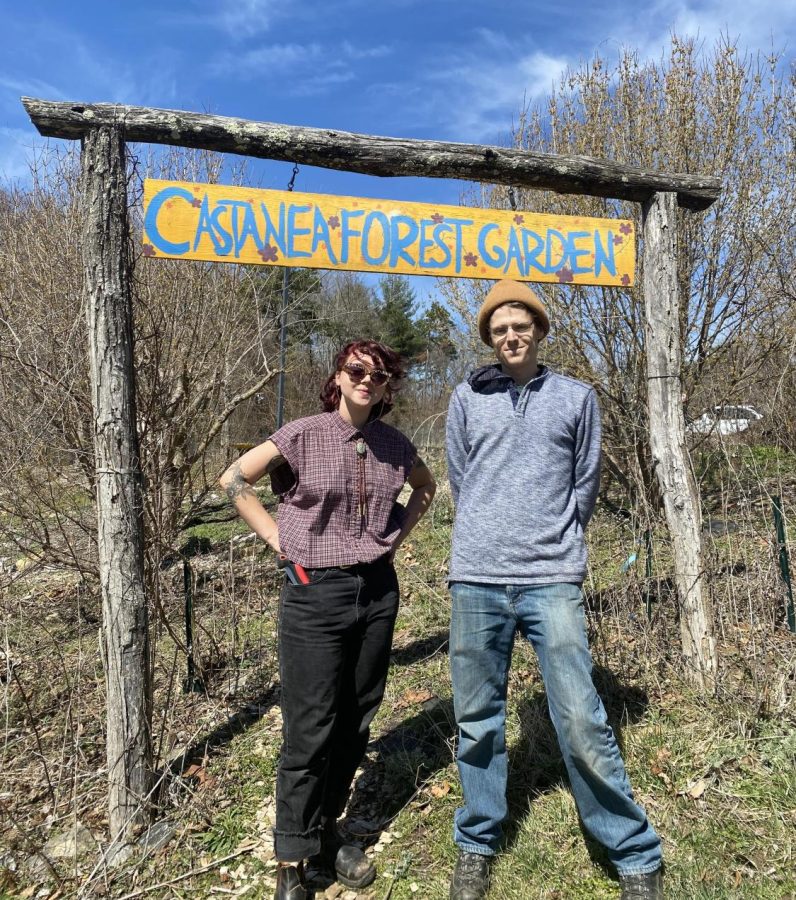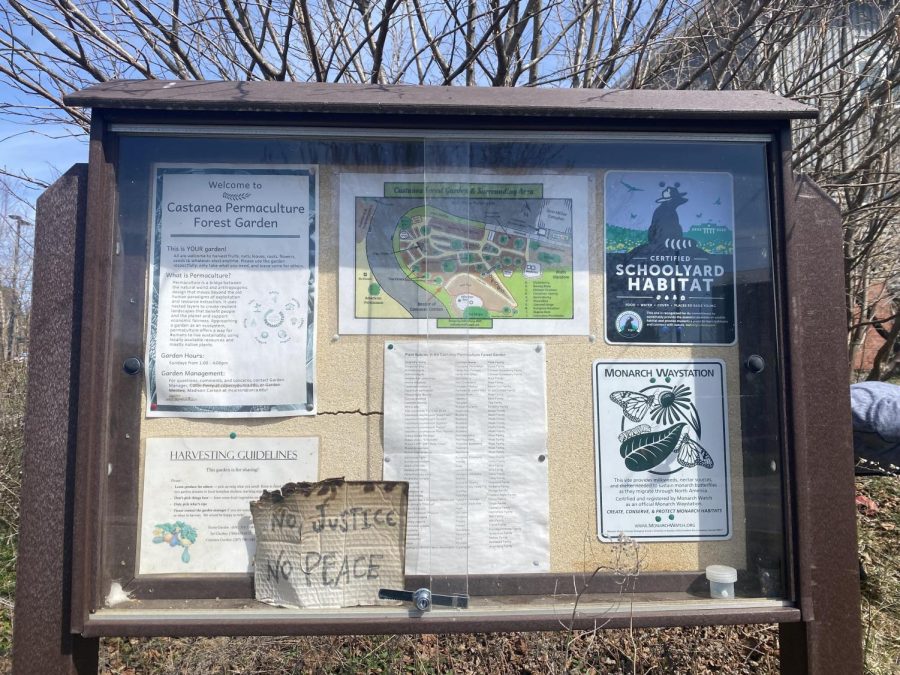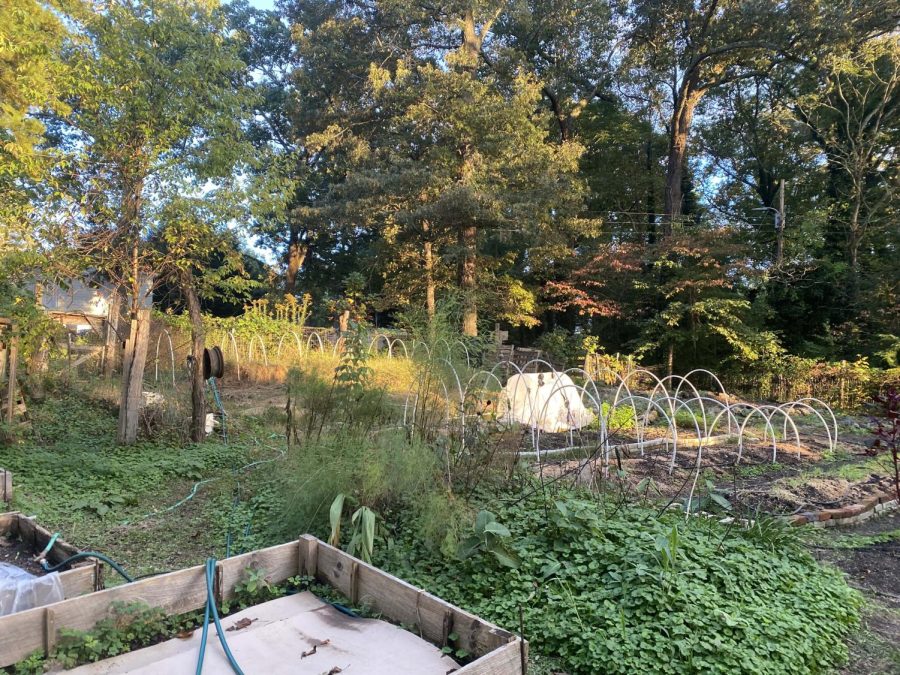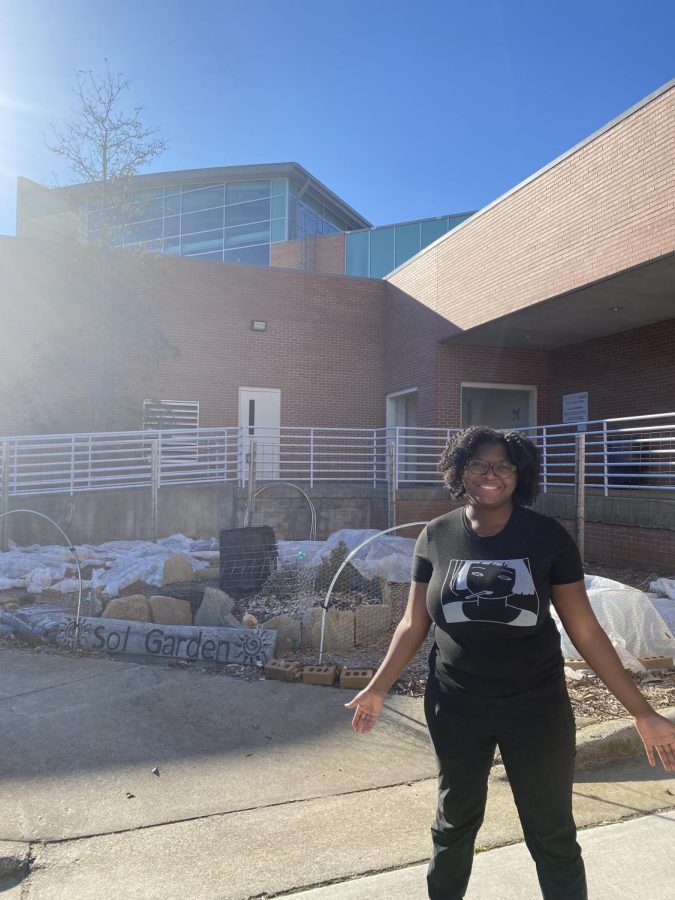Generational Gardening: Passing Seeds of Growth Gardens in UNCA’s campus gardens
May 22, 2022

(Addison Wright)
It was 12:30 p.m. on a Monday—between classes, meetings and practice. I found myself sitting in warm grass with a pair of shears and one glove, at a UNC Asheville Castanea pruning garden workshop, fisting a tangle of twirling branches in hopes of giving a grape plant a chance to breathe and grow. A first for me. Why take time out of a busy day to be here?
On our way to the grapevine, current garden manager Naomi Todd and 2018 garden manager Collin Perry crunched along the wood-chip path and paused to touch soft leaves and tiny buds hidden beneath roots. As I followed Todd and Perry through the garden, my gaze fell from the sky and focused onto the thick, lively and sometimes fading green around me. With a turn of the path, Perry pointed out mulberry trees he had grafted (basically frankenstein trees) under his time as garden manager. A quick turn and I found myself staring at a hop plant. Perry bent down to support a tiny bud through his fingers, praising its growth, a hopeful sign for the plant and I became absorbed into a discussion about plant families and scientific names.
Perry explains that grapevines don’t produce much unless you prune them.
The nondescript hill I sped by on my commute to campus now overflowed with history, and I began to understand that it was the result of generations of pruning – an intersection of exchanged knowledge, a place of healing and an opportunity for community.
As the gardens cycle through different seasons, knowledge is passed from garden manager to garden mentee and so on. Each garden is a living product rooted through layers of people from all paths of life. Past, present and future.
Garden mentees start in the winter, when both they and the gardens begin anew.
“When I got hired I had no idea what I was doing,” Todd said. “I had gardened, but I grew up in a city and I hadn’t ever had this much space. I didn’t even know where to start and pretty much just had to try everything and make a lot of mistakes.”
Like the grapevines, trees and buds they take care of, the garden managers also rely on a structure of past guidance as they enter in a cycle of growth, transitioning from winter into nourishing April rains.
As I curved through the garden behind Todd and Perry, Todd gestured their hand towards a sign filled with garden information, muttering that they had been looking for the key for over a year.
Perry quickly paced to the shed and pulled out the key.
Turns out, Perry had built the sign years back, along with all the information inside it, even establishing the garden as schoolyard habitat and monarch waystation certified.

(Addison Wright)
Less than 500 years ago the area now known as Asheville, NC was inhabited by the Cherokee people. Arrowheads and other artifacts can still be found on the Rhoades property of the first UNC Asheville garden, Roots. On this land the Cherokee people produced gardens of corn, beans, squash, wild greens, blueberries, chestnuts, acorns, black walnuts and many more.
Now, this land is tended to by Roots garden manager Evie Horton to produce garlic, lemon balm, sage, chocolate mint, beets, oregano, shiitake mushrooms, cover crop and more – all overlooked by towering walnut trees, which can live up to 200 years.

The oak trees and their land has been passed through more hands than from garden manager to mentee.
After the Cherokee population suffered immensely at the hands of European settlers and disease, the post-Revolutionary War Weaver family obtained much of the land in the Bent Creek area in East Asheville.
This land was then inherited by W.T Weaver’s grandson Verne Rhoades, a graduate of the first forestry school in the nation, Biltmore Forest School and supervisor of Pisgah National Forest.
Rhoades and his family donated the 9.5-acre Rhoades Property to the university, hoping to leave it in the hands of those that valued conservation and community.
Students, community members, faculty and staff came together to establish a student-led garden on this weathered land.
The Student Environmental Center offered the funding for this project, and the gardens are now funded by the green fee.
“Students presented a proposal to the University Fee Committee during the 2007-2008 school year. A separate proposal was made by the Student Government Association, in support of the general principle of a green fee but stipulating that the funds should be used to support sustainability on campus. The Fee Committee approved and established the Green Fee,.” said Jacqueline Hamstead, UNCA co-director of sustainability.
A pattern of student-led initiatives prunes these gardens, sustaining them.
The first manager, Jordan Ellis, invited community organizations to participate. Student David Clarke brought in faculty members, including current UNCA professor Dee Eggers.
The second manager, Ryan Rosemond, expanded the garden space and helped build a hoop house for community plant production with other students and the non-profit Bountiful Cities.
The third manager, Brian Sanders, focused on expanding production and ecological diversity.
Garden manager contracts are not annual, as they last only a year, and thus must be planted anew every year.
UNCA’s Sol Garden manager Audrey McHenry remembers her first moment alone on the job.
“I didn’t know what to grow, didn’t know anything about anything,” McHenry said. “I’m so used to having somebody else telling me what to do. This time I got to choose, which was very empowering for me.”
Yet- like perennial plants, the garden manager job continually reoccurs every year for a seemingly infinite amount of time. College students roll in and out of the university, but something keeps the garden managers connected. McHenry often texts previous Sol garden manager Danny Tipps for wisdom and advice.
“Danny is the godfather of the gardens and of compost,” McHenry said. “If I really need help, I know there is somebody looking out for me that was here before me and knows how to do this. Even my mentee goes to Danny. Everybody goes to Danny.”
This relationship between annual individual garden managers working in a perennial job has created a diversity and connection of knowledge that mulches the land.
Now, after over a year of experience in Sol, McHenry recalls with pride moments of bringing food that she has grown to SEC staff dinners.

This food can not be grown without weather containing some rain. Running a garden single-handedly as a full-time student is a huge responsibility, with little support other than from past garden managers.
“A place where the SEC could grow a lot is having more employees because it is a lot of responsibility for one person to be in charge of a garden and Roots is a huge space and there is one person working for most of the year,” Todd said.
Recently, the green fee was cut due to decreased enrollment and a reallocation of funds during COVID-19. It has not yet been raised, and so the SEC does not have the funds to hire additional employees.
Working these gardens as the only manager is oftentimes a fight to balance maintaining them while still meeting others standards and expectations of aesthetics.
“A groundhog came in and started eating everything and I had to build a fence and later on people were complaining because the fence was ugly but I was trying my best,” McHenry said.
Initiatives in the gardens, like implementing fences, along with resource needs are required to go through UNCA’s groundskeeping department. However, this structure of support has become inefficient and now adds more loopholes for the managers to jump through.
“There are times when I need to communicate with grounds, but the problem is sometimes it won’t get done in a reasonable time and will take months or will never happen,” McHenry said.
Todd placed an order for pruners, chicken wire and more in November and never received it.
Throughout their journey under this stormy weather, garden managers witness the green buds of healing and connection that poke through the dirt. Signs of spring.
For McHenry, normal workdays usually consist of working, talking and gardening together. People are not required to stay the entire time, but can come by, say hello, have a chat, then go on with their days.
The gardens both bring people together and to the land in a healing way.
“The week before spring break I was having a hard time, and then I went to a garden workday at Castanea and it healed me, literally healed me,” McHenry said. “I love gardening for that.”
Both McHenry and Todd now enter a new spring, with garden mentees Sam McIntosh and Gillian Gavenus by their sides.
“My freshman year I saw how involved the Student Environmental Center was on campus, and I knew I wanted to become a part of the changes they were making towards sustainability on our campus,” Gavenus said. “There is something so special about planting food for yourself and neighbors.”
Gavenus strikes something at the core of gardening with the word “neighbor.” These campus gardens are not limited to garden managers and mentees, but are open to the community, an ecological network of connections and new understanding.
Todd and a few other UNCA students had the chance to experience Castanea garden through the lens of a group of young kids from an Asheville Science Museum camp this past summer.
Fifteen eight to ten-year-olds ran around the Castanea garden hill, picking and touching everything.
“A lot of the kids that came here had never been to a garden like this, did not know anything about vegetables or how plants grow, which makes sense, so it was cool to see their excitement,” Todd said. “I feel it is important to understand where your food comes from and visualizing that is a privilege because if you have the space and time to grow food that’s a privilege.”
Both Todd and the children learned from each other, and Todd was reminded of the child-like wonder gardens are able to evoke, while passing their experiential knowledge to a new generation.
As they gain new knowledge and engage in a perennial cycle of other gardeners, garden managers maintain a sense of wonder for the land.
“My favorite workday was when we ended the workday by laying in a bed of chickweed,” McHenry said. “It was a warm day and the chickweed was so cool and we just layed down and looked at the sky.”’
Gardens connect us back to the earth, to the food we eat, to others, to past wisdom and so much more. What was I doing at a Castanea pruning garden workday? I was not sure before, but soon learned with my feet in the grassy dirt and my hands in the twigs, how much I underestimated the healing powers of connection to the land. The importance of understanding it and its seasons and how that understanding gives us the care to prune it.